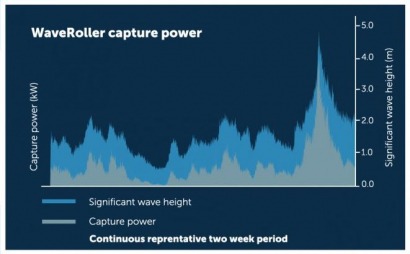
WaveRoller received its validation after operating in fully exposed ocean environment during testing campaigns in 2012 and 2013.
AW-Energy then submitted detailed data covering wave conditions and device performance for external verification. Independent verification of the WaveRoller power matrix signifies a major milestone for near-shore wave energy converters on their way to commercialization and large scale deployment.
The electricity output from a single WaveRoller 100kW-unit during a 24-hour period with significant wave height of 2.5 meter, typical at the Peniche project site in Portugal was 500 kWh.
WaveRoller continued to operate as predicted even during more turbulent periods with 5 meter significant wave height. The continuous operation of WaveRoller in such harsh conditions was possible due to "intelligence" built into the PTO system, developed by AW-Energy.
The WaveRoller device is equipped with a large array of sensor and measurement equipment that monitor the operating conditions and performance of the device. The recorded data is instantly available in the control room in Portugal, as well as by remote connection.
The 2012 and 2013 grid-connected and fully operational hours delivered much data for various device settings and operating conditions. Out of these, a half-month most representative sample with continuous operation has been independently selected for verification.
The extensive study and performance verification was conducted by the leading technical advisory to the renewable energy industry, DNV GL (formerly Garrad Hassan & Partners Ltd). The aim of the study was to impartially examine the performance of WaveRoller, verify the efficiency of the device at different stages of power conversion and, derive a power matrix for WaveRoller.
Raw data analysis and verification of data processing algorithms within the measurement instrumentation were also included in the review to ensure reliability of key input variables.
The DNV GL study results were all very well in line with AW-Energy’s own calculations. The power captured by WaveRoller was consistent in both calculations, equally for low and high sea states.
DNV GL verified that the hydraulic stage of the Power Take-Off (PTO) showed excellent performance and electricity was generated even in very mild conditions of about 1m significant wave height.
“DNV GL and AW-Energy have been working closely to establish an appropriate framework for the design of the WaveRoller wave energy converter (WEC). This has involved a series of numerical and experimental modelling exercises, which have now been extended to the comparisons with full-scale results. The results are very encouraging, and demonstrate AW-Energy’s adherence to the industry best practices. This positions the WaveRoller WEC technology at the forefront of the wave energy industry.” said Joao Cruz, Head of Wave and Tidal Energy at DNV GL.
Previous WaveRoller PTO bench tests and simulations also matched field performance, providing significant impetus for AW-Energy’s newest project: a full scale PTO- testing-facility, currently under construction in Finland. Full-scale next-generation WaveRoller PTO units will undergo rigorous operational tests at the facility. The results will provide a solid basis for performance estimates of the upgraded design.
“To our understanding, AW-Energy is the first wave energy technology company to conduct such an extensive independent verification of its operational results. This proves that wave surge converters like WaveRoller are clearly becoming the industry standard for near-shore wave energy.” said Mr. John Liljelund, CEO of AW-Energy.
For additional information:

